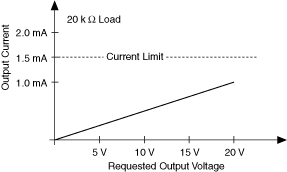Compliance
For power supplies and SMUs, a channel is operating in compliance when it cannot reach the requested output level because the programmed limit has been reached.
The following two figures help to graphically describe compliance for a specific application: the output function is set to NIDCPOWER_VAL_DC_VOLTAGE using the niDCPower_ConfigureOutputFunction function or DC Voltage using the niDCPower Configure Output Function VI with a 1.5 mA current limit.


Because the 20 kΩ load resistance in the figure on the left never allows the output current to exceed the current limit of 1.5 mA (given a maximum requested voltage of 20 V), the source driving this load never enters compliance. This circuit always operates in Constant Voltage mode.
In contrast, the 10 kΩ load resistance in the figure on the right causes a higher current draw. The output voltage of the power supply or SMU operates in Constant Voltage mode up to 15 V. Above the 15 V requested output, the load draws 1.5 mA, thus the source operates in Constant Current mode at the current limit. While operating at the current limit, the channel is said to be in compliance. In this case, although the requested output voltage is > 15 V, the actual voltage does not exceed 15 V because the current limit has been reached.
You can query a channel to determine if it is in compliance using the niDCPower Query in Compliance VI or the niDCPower_QueryInCompliance function.
 |
Note The NI-DCPower Soft Front Panel displays Cmpl when a channel is in compliance. |